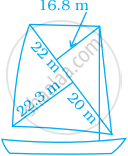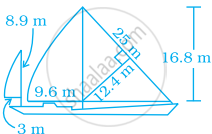Advertisements
Advertisements
प्रश्न
The figure ABCD is a quadrilateral in which AB = CD and BC = AD. Its area is ______.

विकल्प
72 cm2
36 cm2
24 cm2
18 cm2
उत्तर
The figure ABCD is a quadrilateral in which AB = CD and BC = AD. Its area is 36 cm2.
Explanation:

It is clear from the figure that, quadrilateral ABCD is a parallelogram. The diagonal AC of the given parallelogram ABCD divides it into two triangles of equal areas.
Area of the ΔABC = `1/2 xx "Base" xx "Height"`
= `1/2 xx 12 xx 3`
= 18 cm2
∴ Area of parallelogram ABCD = 2 × Area of ΔABC
= 2 × 18
= 36 cm2
APPEARS IN
संबंधित प्रश्न
Lengths of the diagonals of a rhombus are 15 cm and 24 cm, find its area.
The diagonals of a rhombus are 18 cm and 24 cm. Find:
(i) its area ;
(ii) length of its sides.
(iii) its perimeter
Find the missing value.
| Diagonal (d1) | Diagonal (d2) | Area |
| 12 mm | 180 sq.mm |
The area of a rhombus is 100 sq.cm and length of one of its diagonals is 8 cm. Find the length of the other diagonal
The area of the rhombus with side 4 cm and height 3 cm is
If the diagonals of a rhombus get doubled, then the area of the rhombus becomes ______ its original area.
Area of a rhombus = `1/2` product of ______.
Most of the sailboats have two sails, the jib and the mainsail. Assume that the sails are triangles. Find the total area sail of the sailboats to the nearest tenth.

Most of the sailboats have two sails, the jib and the mainsail. Assume that the sails are triangles. Find the total area of sail of the sailboats to the nearest tenth.

